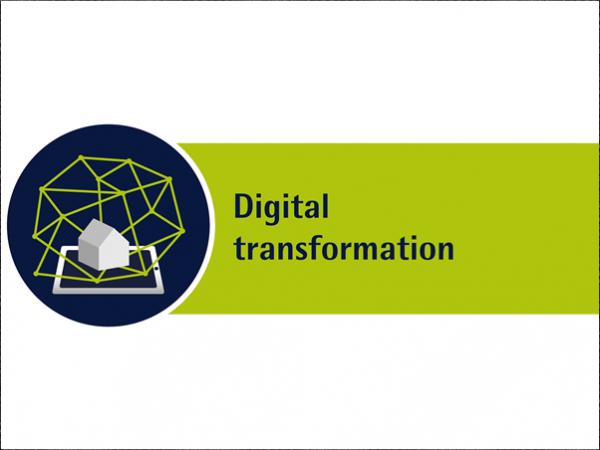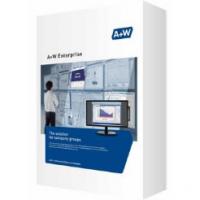
Date: 25 August 2020
Many exhibitors will align their presentations with these themes and showcase solutions. In the forums at the fair, the key themes will be explored and discussed from a range of aspects. And in the special shows they will be illustrated using examples of products and projects. Below we present the third of those key themes: Digital transformation.
The building sector is undergoing a digital revolution. The Corona pandemic, which since the spring of 2020 has brought unimagined change to our working and social lives, is accelerating this process within the sector—an unintended effect, but nevertheless a powerful one. Within a few weeks decentralized working—from the home office—and video-conference meetings about buildings projects became standard day-to-day working practice.
Every company, not just those involved in manufacturing, adjusted to digital working processes. It seems almost paradoxical: During the struggle to beat this virus, the world of building is reacting to the rigid, sometimes paralyzing restrictions on movement and working with technical improvisation, using Corona as a driver of digitalization right across the sector.
This is prompting a transformation from analog scenarios in planning and implementation to proficient, digital decision-making and working processes, and that in turn presents a range of options and offers significant potential. The important thing is to identify and make the most of this potential. For building as a collaborative process involving many partners, the digital transformation is above all this: Open thinking and working in integrated structures. That is not new, because teamwork and cooperation have always been anchored in the building process. What is changing are the ways in which we will in future plan, build, manage, renovate, dismantle and recycle buildings. At the same time open communication in a project and efficient, integrated working processes will become ever more important.
Building Information Modeling is digitalizing the building sector
A host of new and very useful tools is already available to support the partners in architectural and planning offices, in the government authorities and institutions and in research and technological development: Digital planning methods such as BIM and a cross-platform open BIM process are supplementing the toolbox available to those involved in planning and building. An open and unrestricted exchange of data and information is the basis for open BIM. Manufacturer-independent program interfaces such as IFC and BCF are facilitating low-loss exchange of information and communication, and promoting successful cooperation in the building project.
Digital planning and building processes that focus on the whole life cycle of a building most definitely offer interesting potential for the future. Yet what is implied here is not the often-quoted BIM, the new planning method that brings changes to processes in architectural and engineering practices, on the building site and in facility management. Rather it is how to use the wealth of data and information, checklists, specialist planning details, protocols and monitorings that arise in any building project.
For the potential of all this information for the entire process of planning and building, as well as subsequent management, is immense. The participants must, however, learn to ensure the accuracy of planning data and how to use that data sensibly in the building process and in building operation. It all helps, for example, in avoiding errors during the construction stage, and in improving the quality of the built environment, by ensuring buildings are sustainable and long-lasting.
Building industry in Germany has second highest digitalization potential
In this context what´s needed are in any case comprehensive strategies that see a building not as an investment, but as a contribution to society in terms of the urban or built environment. The term “building culture” expresses this important obligation: Our streets and houses, bridges and tunnels are not solely a functional component in a prosperous region, town or local community. Combined with attractive aesthetics and design, these constructions can deliver real added value to the built environment.
Digital planning and building is embedded in the transformation of the analog environments in which we work and live. It cannot be viewed in isolation; integration and the digitalization of standard processes will facilitate building in the future. And that is urgently needed, when you look at the current low level of digitalization in building: In Germany today building is second from bottom in the Digitalization Index.
Only fishing is even less digitalized. Yet the benefits of digitalization in terms of optimizing prefabrication and high precision thanks to digital production processes cannot be denied. Nevertheless, even in the building sector, we are seeing the emergence of the first solutions and ideas as part of this process of transformation. For example, it is already standard practice to transfer planning data direct from the BIM model into production data for CNC milling, and thereby fabricate millimeter-precise joints on a roof frame. Also, it is already possible to produce entire houses using a 3D concrete printer, and to build walls, floors and support structures using a bricklaying robot.
Digitalization combines the skilled trades, digital planning and robotics
There´s no denying that in the coming years and decades robots will continue to transform our industrial manufacturing processes. Indeed robot technology is already being used, to a greater or lesser extent, in all relevant sectors of the economy, including in building. However, a willingness to switch to digital planning or digitalized production methods is not in itself a guarantee of a trouble-free future.
On the contrary: In architectural and planning offices, on building sites and in the building authorities, human expertise will continue to be in demand. What´s critical as regards the future of building will be the interaction between digital planning, quality craft skills and robot production—including for one-off designs or individualized mass produced components.
Our building sites will have to react quickly to the upcoming digital transformation. Extra pressure on the German building industry comes from the shortage of skilled workers on the one hand and on the other, the need for properly qualified people for programming and using digital tools on the building project. Changes to requirements and new job profiles are coming up here against a building sector characterized by a more traditional view of the trades.
Adopting new ways means transferring analog building processes into a digital world of construction. Yet it is a fact that digital tools on their own will not create better architecture. Conversely, we should not accept a loss of architectural quality because of advancing automation in building. These are simply tools which facilitate the road towards digitalization for architects, planners, the skilled trades and building owners and optimize the whole process of building construction and management.
 600450
600450
















Add new comment